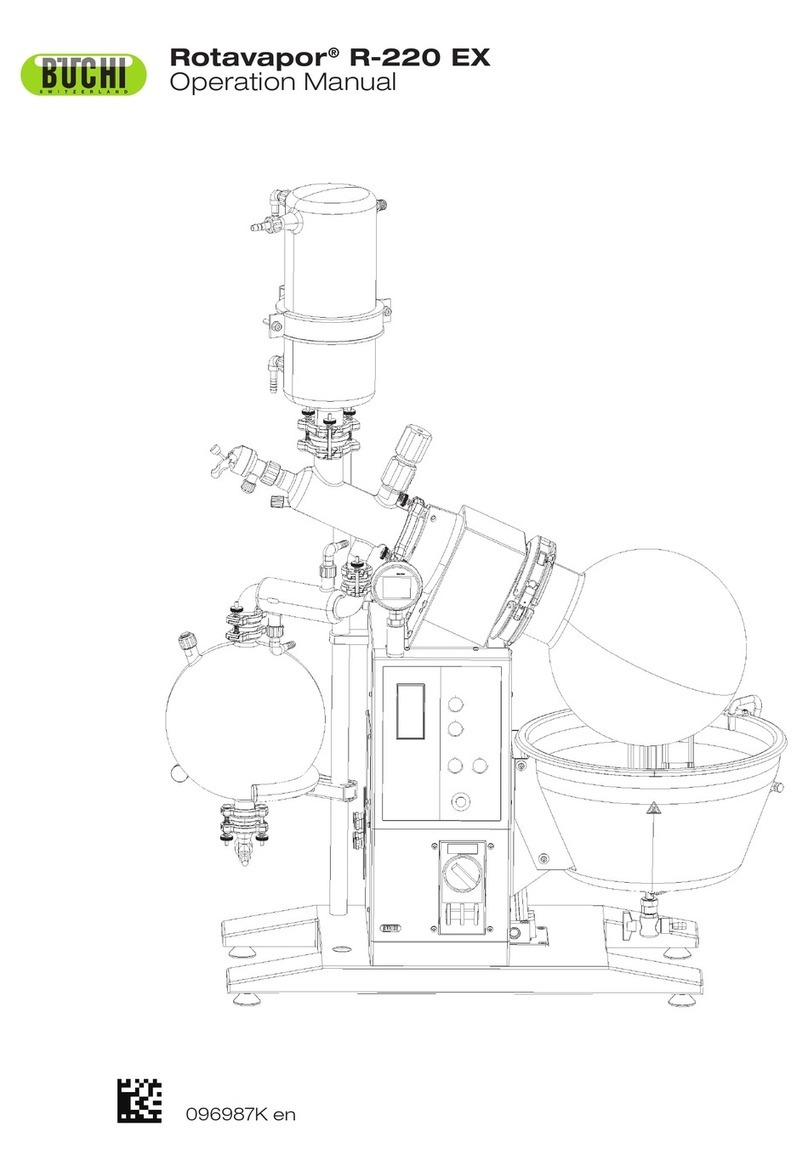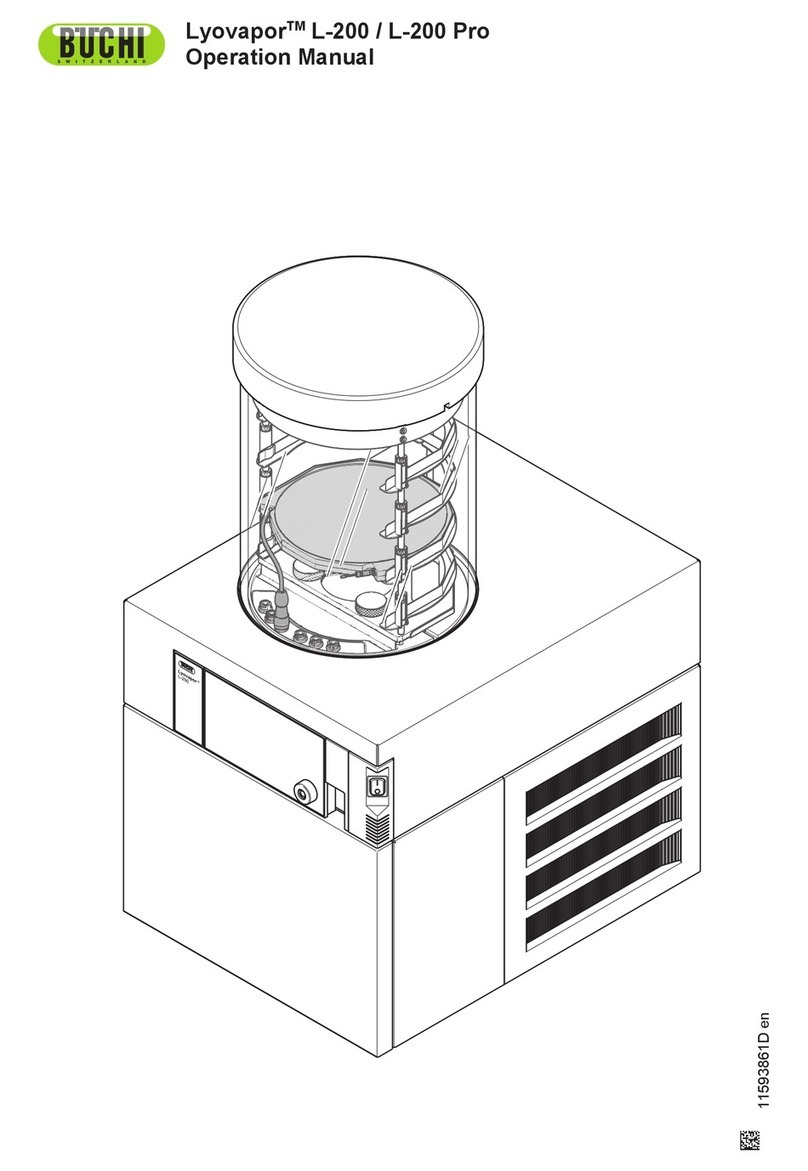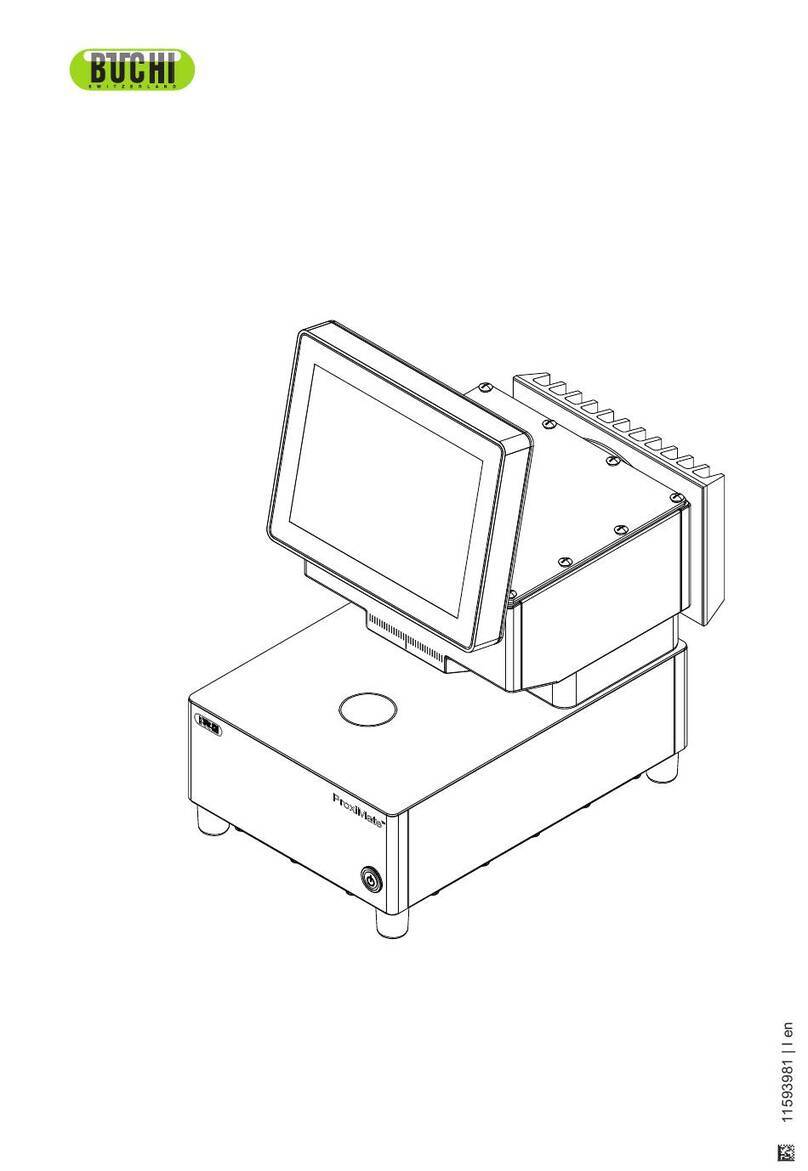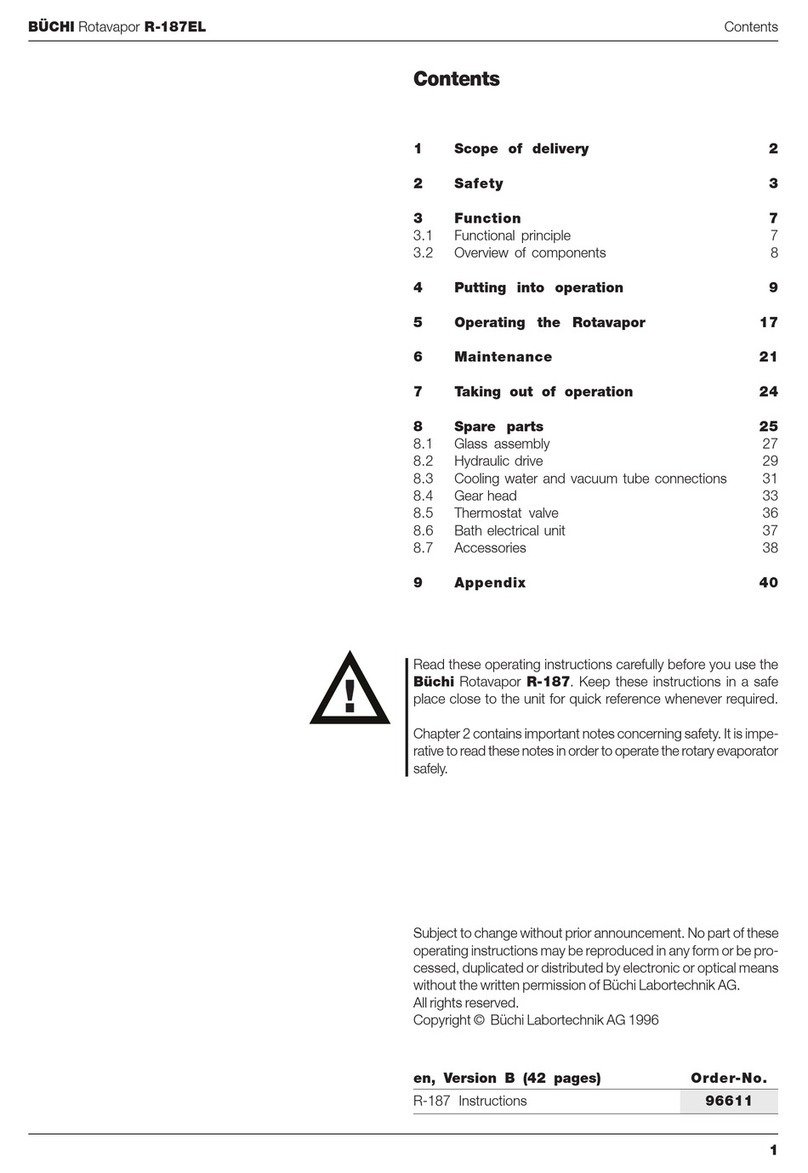Buchi B-295 SE User manual

Inert Loop B-295 SE
Operation Manual
STOP
START
11594141 | B en

Imprint
Product Identification:
Operation Manual (Original) Inert Loop B-295 SE
11594141
Publication date: 11.2020
BÜCHI Labortechnik AG
Meierseggstrasse 40
Postfach
CH-9230 Flawil 1
E-Mail: [email protected]
BUCHI reserves the right to make changes to the manual as deemed necessary in the light of experi-
ence, especially with respect to structure, illustrations and technical details.
This manual is copyrighted. Information from it may neither be reproduced, distributed, or used for com-
petitive purposes, nor made available to third parties. The manufacture of any component with the aid of
this manual without prior written agreement is also prohibited.

BÜCHI Labortechnik AG Table of contents
Operation Manual Inert Loop B-295 SE iii
Table of contents
1 About this document...........................................................................................................5
1.1 Warning notices in this document........................................................................................................ 5
1.2 Symbols............................................................................................................................................... 5
1.2.1 Warning symbols .....................................................................................................................5
1.2.2 Mark-ups and symbols.............................................................................................................5
1.3 Connected devices .............................................................................................................................. 6
1.4 Trademarks.......................................................................................................................................... 6
2 Safety....................................................................................................................................7
2.1 Proper use ........................................................................................................................................... 7
2.2 Use other than intended ...................................................................................................................... 7
2.3 Staff qualification ................................................................................................................................. 7
2.4 Residual risks ...................................................................................................................................... 8
2.4.1 Faults during operation ............................................................................................................8
2.5 Personal protective equipment ............................................................................................................ 8
2.6 Modifications........................................................................................................................................ 8
3 Product description...........................................................................................................10
3.1 Description of function ....................................................................................................................... 10
3.2 Configuration ..................................................................................................................................... 11
3.2.1 Front view ..............................................................................................................................11
3.2.2 Side connections....................................................................................................................12
3.2.3 Control elements....................................................................................................................12
3.2.4 Type plate ..............................................................................................................................12
3.3 Scope of delivery ............................................................................................................................... 13
3.4 Technical data ................................................................................................................................... 13
3.4.1 Inert Loop B-295 SE ..............................................................................................................13
3.4.2 Ambient conditions.................................................................................................................14
3.4.3 Materials ................................................................................................................................15
4 Transport and storage ......................................................................................................16
4.1 Transport ........................................................................................................................................... 16
4.2 Storage .............................................................................................................................................. 16
4.3 Lifting the instrument ......................................................................................................................... 16
5 Installation..........................................................................................................................18
5.1 Before installation .............................................................................................................................. 18
5.2 Installation site................................................................................................................................... 18
5.3 Establishing electrical connections.................................................................................................... 18
5.4 Installing the oxygen sensor .............................................................................................................. 19
5.5 Connecting the Inert Loop B-295 SE with a spray drying system...................................................... 20
5.6 Installing the exhaust gas hose ......................................................................................................... 21
5.7 Installing the solvent receiving vessel................................................................................................ 21
6 Operation............................................................................................................................23
6.1 Preparing the instrument ................................................................................................................... 23
6.2 Starting the instrument....................................................................................................................... 23
6.3 Tasks during spray drying.................................................................................................................. 23
6.4 Shutting down the instrument ............................................................................................................ 24
6.5 Switching off the instrument............................................................................................................... 24
6.6 Setting condenser temperature ......................................................................................................... 24

Table of contents BÜCHI Labortechnik AG
iv Operation Manual Inert Loop B-295 SE
7 Cleaning and servicing .....................................................................................................25
7.1 Regular maintenance work................................................................................................................ 25
7.2 Cleaning the instrument..................................................................................................................... 25
7.3 Empty the solvent receiving vessel.................................................................................................... 28
8 Help with faults ..................................................................................................................29
8.1 Calibrating the oxygen analyzer ........................................................................................................ 29
8.2 Changing the oxygen sensor............................................................................................................. 31
8.2.1 Removing the oxygen sensor ................................................................................................31
8.2.2 Installing the oxygen sensor ..................................................................................................32
8.3 Error messages ................................................................................................................................. 33
9 Taking out of service and disposal..................................................................................34
9.1 Taking out of service.......................................................................................................................... 34
9.2 Refrigerant......................................................................................................................................... 34
9.3 Disposal............................................................................................................................................. 34
9.4 Returning the instrument ................................................................................................................... 34
10 Appendix ............................................................................................................................35
10.1 Spare parts and accessories ............................................................................................................. 35
10.1.1 Spare parts ............................................................................................................................35

BÜCHI Labortechnik AG About this document | 1
Operation Manual Inert Loop B-295 SE 5/38
1 About this document
This operation manual is applicable for all variants of the instrument.
Read this operation manual before operating the instrument and follow the instruc-
tions to ensure safe and trouble-free operation.
Keep this operation manual for later use and pass it on to any subsequent user or
owner.
BÜCHI Labortechnik AG accepts no liability for damage, faults and malfunctions re-
sulting from not following this operation manual.
If you have any questions after reading this operation manual:
uContact BÜCHI Labortechnik AG Customer Service.
https://www.buchi.com/contact
1.1 Warning notices in this document
Warning notices warn you of dangers that can occur when handling the device. There
are four danger levels, each identifiable by the signal word used.
Signal word Meaning
DANGER Indicates a danger with a high level of risk which could result in
death or serious injury if not prevented.
WARNING Indicates a danger with a medium level of risk which could result in
death or serious injury if not prevented.
CAUTION Indicates a danger with a low level of risk which could result in mi-
nor or medium-severity injury if not prevented.
NOTICE Indicates a danger that could result in damage to property.
1.2 Symbols
The following symbols are displayed in this operation manual or on the device:
1.2.1 Warning symbols
Symbol Meaning
General warning
Device damage
Health-harming or irritant substances
1.2.2 Mark-ups and symbols
NOTE
This symbol draws attention to useful and important information.
RThis character draws attention to a requirement that must be met before the in-
structions below are carried out.
uThis character indicates an instruction that must be carried out by the user.

1 | About this document BÜCHI Labortechnik AG
6/38 Operation Manual Inert Loop B-295 SE
ðThis character indicates the result of a correctly carried out instruction.
Mark-up Explanation
Window Software Windows are marked-up like this.
Tab Tabs are marked-up like this.
Dialog Dialogs are marked-up like this.
[Button] Buttons are marked-up like this.
[Field names] Field names are marked-up like this.
[Menu / Menu item] Menus or menu items are marked-up like this.
Status Status is marked-up like this.
Signal Signals are marked-up like this.
1.3 Connected devices
In addition to these operating instructions, follow the instructions and specifications in
the documentation for the connected devices.
1.4 Trademarks
Product names and registered or unregistered trademarks that are used in this docu-
ment are used only for identification and remain the property of the owner in each
case.

BÜCHI Labortechnik AG Safety | 2
Operation Manual Inert Loop B-295 SE 7/38
2 Safety
2.1 Proper use
The instrument is designed and built for laboratories.
The instrument can be used for the following tasks:
Condense solvent vapors from the stream of drying gas coming from BUCHI Spray
Drying Instruments in closed mode.
Work under inert condition with BUCHI Spray Drying Instruments.
Monitoring the O2 level in closed mode.
2.2 Use other than intended
Use of any kind other than that described in Chapter2.1 "Proper use", page7 and
any application that does not comply with the technical specifications ( See Chap-
ter3.4 "Technical data", page13) constitutes use other than that intended.
In particular, the following applications are not permissible:
Use of the instrument in rooms which require ex-protected instruments.
Use of the instrument with non-BUCHI instruments.
Use of the instrument for processing substances outside of research and develop-
ment.
Use of the instrument outside a fume hood.
Use of the instrument with samples with unknown chemical composition.
Use of the instrument with substances that react with the materials used. See
Chapter3.4 "Technical data", page13
Use of the instrument with toxic substances without appropriate safety measures.
Use of the instrument with biohazardous materials such as viruses or bacteria.
Use of the instrument with corrosive samples.
Use of the instrument with solvents with boiling points which are less than 39 °C.
Use of the instrument with solvents with melting points which are more than 6 °C.
Use of the instrument without Dehumidifier with solvents containing more than 10
% water.
Use of the instrument with solvents containing peroxides.
Use of the instrument with samples, which can explode or inflame (example: explo-
sives, etc.) due to shock, friction, heat or spark formation.
Damage or hazards attributable to use of the product other than as intended are en-
tirely at the risk of the operator alone.
2.3 Staff qualification
Unqualified persons are unable to identify risks and are therefore exposed to greater
dangers.
The device may only be operated by suitably qualified laboratory staff.
These operating instructions are aimed at the following target groups:

2 | Safety BÜCHI Labortechnik AG
8/38 Operation Manual Inert Loop B-295 SE
Users
Users are persons that meet the following criteria:
They have been instructed in the use of the device.
They are familiar with the contents of these operating instructions and the applica-
ble safety regulations and apply them.
They are able on the basis of their training or professional experience to assess
the risks associated with the use of the device.
Operator
The operator (generally the laboratory manager) is responsible for the following as-
pects:
The device must be correctly installed, commissioned, operated and serviced.
Only suitably qualified staff may be assigned the task of performing the operations
described in these operating instructions.
The staff must comply with the local applicable requirements and regulations for
safe and hazard-conscious working practices.
Safety-related incidents that occur while using the device should be reported to the
manufacturer ([email protected]).
BUCHI service technicians
Service technicians authorized by BUCHI have attended special training courses and
are authorized by BÜCHI Labortechnik AG to carry out special servicing and repair
measures.
2.4 Residual risks
The device has been developed and manufactured using the latest technological ad-
vances. Nevertheless, risks to persons, property or the environment can arise if the
device is used incorrectly.
Appropriate warnings in this manual serve to alert the user to these residual dangers.
2.4.1 Faults during operation
If a device is damaged, sharp edges, moving parts or exposed electrical wires can
cause injuries.
uRegularly check device for visible damage.
uIf faults occur, switch off the device immediately, unplug the power cord and in-
form the operator.
uDo not continue to use devices that are damaged.
2.5 Personal protective equipment
Depending on the application, hazards due to heat and/or corrosive chemicals may
arise.
uAlways wear appropriate personal protective equipment such as safety goggles,
protective clothing and gloves.
uMake sure that the personal protective equipment meets the requirements of the
safety data sheets for all chemicals used.
2.6 Modifications
Unauthorized modifications may impair safety and lead to accidents.
uUse only genuine BUCHI accessories, spare parts and consumables.

BÜCHI Labortechnik AG Safety | 2
Operation Manual Inert Loop B-295 SE 9/38
uTechnical modifications to the device or accessories should only be carried out
with the prior written approval of BÜCHI Labortechnik AG and only by authorized
BUCHI technicians.
BUCHI accepts no liability whatsoever for damage arising as a result of unauthorized
modifications.

3 | Product description BÜCHI Labortechnik AG
10/38 Operation Manual Inert Loop B-295 SE
3 Product description
3.1 Description of function
The Inert Loop B-295 SE is an accessory for BUCHI Spray Drying Instruments, which
enables the safe use of organic solvents in closed loop mode.
The spray drying process in closed loop mode generates an inert gas stream loaded
with solvent vapors. The Inert Loop B-295 SE is used to condense these solvent va-
pors from the gas stream and to monitor its oxygen concentration.
The gas flow enters the Inert Loop B-295 SE and passes the preheat exchanger
where it is cooled before entering the condenser. After solvent vapor condensation,
the gas stream is reheated by the preheater before being returned to the spray drying
process. The excess inert gas leaves the Inert Loop B-295 SE via the exhaust and
the condensed solvent vapors are collected in a closed bottle.
The following spray drying modes are available:
Spray drying mode Solvent composition
Open mode up to 20 % organic solvent
Closed mode with B-295
(When using Ultrasonic Package acces-
sory Inertgas adapter is necessary)
between 90 % - 100 % organic solvent
Closed mode with B-295 and B-296
(When using Ultrasonic Package acces-
sory Inertgas adapter is necessary)
between 20 % - 80 % organic solvent

BÜCHI Labortechnik AG Product description | 3
Operation Manual Inert Loop B-295 SE 11/38
3.2 Configuration
3.2.1 Front view
STOP
START
3
4
1
2
5
6
Fig.1: Front view
1 Control elements
(See Chapter3.2.3 "Control ele-
ments", page12)
2 Oxygen analyzer
(Front cover oxygen analyzer)
3 Side connections
(See Chapter3.2.2 "Side connec-
tions", page12)
4 Ventilation slots
5 Castor brake 6 Solvent collection flask

3 | Product description BÜCHI Labortechnik AG
12/38 Operation Manual Inert Loop B-295 SE
3.2.2 Side connections
123
4
5
6
Fig.2: Side connections
1 Process gas out
(marked: OUT)
2 Process gas in
(marked: IN)
3 Exhaust connection
(marked: Exhaust)
4 Type plate
(See Chapter3.2.4 "Type plate",
page12)
5 Communication cable 6 Power connection
(marked: Power IN)
3.2.3 Control elements
1234
5
6
7
8
9
Fig.3: Control elements
1 Display 2 Set temperature up
3 Switch on 4 Signal lamp oxygen
5 Signal lamp pressure 6 Signal lamp power
7 Signal lamp operation 8 Switch off
9 Set temperature down
3.2.4 Type plate
The type plate identifies the instrument. The type plate is located at the left side of the
instrument. See Chapter3.2.2 "Side connections", page12

BÜCHI Labortechnik AG Product description | 3
Operation Manual Inert Loop B-295 SE 13/38
Büch Labortechnik AG
Meierseggstrasse 40 CH - 9230 Flawil / Switzerland
Made in Germany
10
9
1
2
11
12
3
8
4
5
6
714
13
Fig.4: Type plate
1 Instrument name 2 Serial number
3 Article number 4 Refrigerant details
Filling capacity
5 Global warming potential 6 Input voltage range
Frequency
7 Power consumption maximum 8 Fuse type
9 High-pressure system design pres-
sure
10 Low-pressure system design pres-
sure
11 Year of manufacture 12 Company name and address
13 Approvals 14 Symbol for "Do not dispose of as
household waste"
3.3 Scope of delivery
NOTE
The scope of delivery depends of the configuration of the purchase order.
Accessories are delivered as per the purchase order, order confirmation, and deliv-
ery note.
3.4 Technical data
3.4.1 Inert Loop B-295 SE
Inert Loop
B-295 SE
230 V / 50
Hz
Inert Loop
B-295 SE
220 V / 60
Hz
Inert Loop
B-295 SE
200 V / 50
Hz
Inert Loop
B-295 SE
200 V / 60
Hz
Power consumption 1600 VA 1910 VA 1650 VA 1910 VA
Connection voltage 220 ... 240
VAC
208 ... 220
VAC
200 VAC 200 VAC
Fuse (Characteristic) 10 A (T) 10 A (T) 10 A (T) 10 A (T)
Frequency 50 Hz 60 Hz 50 Hz 60 Hz

3 | Product description BÜCHI Labortechnik AG
14/38 Operation Manual Inert Loop B-295 SE
Inert Loop
B-295 SE
230 V / 50
Hz
Inert Loop
B-295 SE
220 V / 60
Hz
Inert Loop
B-295 SE
200 V / 50
Hz
Inert Loop
B-295 SE
200 V / 60
Hz
Overvoltage category II II II II
Degree of protection l l l l
Pollution degree ll ll ll ll
Dimensions (W x D x H) 657 x 653
x 680 mm
657 x 653
x 680 mm
657 x 653
x 680 mm
657 x 653
x 680 mm
Weight 98 kg 98 kg 99 kg 99 kg
Refrigerant R449A,
CFC free
R449A,
CFC free
R449A,
CFC free
R449A,
CFC free
Filling amount of refrigerant 0.98 kg 0.98 kg 0.98 kg 0.98 kg
CO₂-equivalent 1369.06 kg
CO₂
1369.06 kg
CO₂
1369.06 kg
CO₂
1369.06 kg
CO₂
Safety Group Refrigerants
(ASHRAE)
A1 (lower
toxicity, no
flame
propaga-
tion)
A1 (lower
toxicity, no
flame
propaga-
tion)
A1 (lower
toxicity, no
flame
propaga-
tion)
A1 (lower
toxicity, no
flame
propaga-
tion)
Maximum allowable pressure
(PS) [low pressure side]
22 bar 22 bar 22 bar 22 bar
Maximum allowable pressure
(PS) [high pressure side]
26 bar 26 bar 26 bar 26 bar
Cooling capacity at the process
gas (at -23 ° C)
800 W 920 W 800 W 920 W
Compressor cooling capacity
(according to EN12900, at -15 °
C)
1334 W 1925 W 1334W 1925 W
Control range process gas tem-
perature
min -30 to
8°C
min -30 to
8 °C
min -30 to
8 °C
min -30 to
8 °C
Minimum distance to all sides 300 mm 300 mm 300 mm 300 mm
EMC to EN 61326-1 Emmission Class B Class B Class B Class B
EMC to EN 61326-1 Immision Industry Industry Industry Industry
3.4.2 Ambient conditions
For indoor use only.
Max. altitude above sea level 2000 m
Ambient temperature 5‒40 °C
Maximum relative humidity 80 % for temperatures up to 31 °C
decreasing linearly to 50 % relative hu-
midity at 40 °C
Storage temperature max. 40 °C

BÜCHI Labortechnik AG Product description | 3
Operation Manual Inert Loop B-295 SE 15/38
3.4.3 Materials
Component Materials of construction
Hose connections, tubing, weld-on nipple Stainless steel 1.4571
Pre-heat exchanger, condensate separa-
tor
Stainless steel 1.4301
Plate heat exchanger Stainless steel 1.4401
Screw connections, Ball valve Stainless steel 1.4408
Sealing ball valve PTFE
Pipe elbow Stainless steel 1.4307
Pressure switch PVDF, Viton, NBR/aramid fiber compos-
ite
Oxygen sensor PA, PPS, PTFE, stainless steel
Black hoses EPDM
Drain tube PVC
Woulff bottle Glass
Plate heat exchanger Stainless steel solder

4 | Transport and storage BÜCHI Labortechnik AG
16/38 Operation Manual Inert Loop B-295 SE
4 Transport and storage
4.1 Transport
NOTICE
Risk of breakage due to incorrect transportation
uMake sure that all parts of the device are safely packed in such a way as to pre-
vent breakage, ideally in the original box.
uAvoid sharp movements during transit.
uAfter transportation, check the device for damage.
uDamage that has occurred in transit should be reported to the carrier.
uKeep packing for future transportation.
4.2 Storage
uMake sure that the ambient conditions are complied with (see Chapter3.4 "Tech-
nical data", page13).
uWherever possible, store the device in its original packaging.
uAfter storage, check the device, all seals and tubing for damage and replace if
necessary.
4.3 Lifting the instrument
WARNING
Danger due to incorrect transportation
The possible consequences are crushing injuries, cuts and breakages.
uThe instrument should be transported by four persons at the same time.
uLift the instrument at the points indicated.

BÜCHI Labortechnik AG Transport and storage | 4
Operation Manual Inert Loop B-295 SE 17/38
STOP
START
Fig.5: Lifting the instrument
uLift the instrument by the base plate next to the castors.

5 | Installation BÜCHI Labortechnik AG
18/38 Operation Manual Inert Loop B-295 SE
5 Installation
5.1 Before installation
NOTICE
Instrument damaged if switched on too early.
After transporting, wait twelve hours before switching on the instrument. The fluid in
the cooling system requires twelve hours to collect in the refrigerant compressor.
5.2 Installation site
The installation site must meet the following requirements:
Firm, nonslip and level surface
Take into account the maximum product dimensions and weight. See Chapter3.4
"Technical data", page13
Do not expose the instrument to any external thermal loads, such as direct solar
radiation.
Clearance on all sides of the instrument must be at least 300 mm.
Make sure there is free flow of air to the side of the instrument.
Do not place loose papers or cloths below or to the sides of the instrument, as
these could impede the air circulation if drawn in.
Put the instrument on the castors.
Make sure that cables / tubes are safe routed.
Make sure the castor brakes are locked.
Place only BUCHI spray dryer on the instrument.
Do not place the instrument near vibration-sensitive devices.
NOTE
Make sure that the power supply can be disconnected at any time in an emergency.
5.3 Establishing electrical connections
NOTE
Observe the legal requirements when connecting the instrument to the power supply.
4Use additional electrical safety features (e.g., residual-current circuit breakers) to
comply with local laws and regulations.
The power supply must fulfil the following conditions:
1. Provide the mains voltage and frequency specified on the type plate of the instru-
ment.
2. Be designed for the load imposed by the instruments connected.
3. Be equipped with suitable fuses and electrical safety features.
4. Be equipped with proper earthing.

BÜCHI Labortechnik AG Installation | 5
Operation Manual Inert Loop B-295 SE 19/38
NOTICE
Risk of property damage and diminished performance due to use of un-
suitable power cables.
The power supply cables supplied with the product by BUCHI precisely match the re-
quirements of the device. If other power cables that do not meet those requirements
are used, the device may be damaged and/or its performance diminished.
uUse only the power supply cables supplied with the product or ordered separately
from BUCHI.
uIf using any other power supply cables, make sure that they match the specifica-
tions on the type plate.
uMake sure that all connected devices are earthed.
uPlug the power cable into the connection on the instrument. See Chapter3.2
"Configuration", page11
uPlug the mains plug into the mains outlet socket.
5.4 Installing the oxygen sensor
uOpen the front cover oxygen sensor.
uRemove the grounding cable from the front
cover oxygen sensor.
uRemove the screw plug.

5 | Installation BÜCHI Labortechnik AG
20/38 Operation Manual Inert Loop B-295 SE
uRemove the foil from the oxygen sensor.
uInstall the new oxygen sensor.
uConnect the sensor cable.
uCalibrate the sensor. See Chapter8.1 "Cali-
brating the oxygen analyzer", page29
uInstall the grounding cable.
uInstall the front cover
5.5 Connecting the Inert Loop B-295 SE with a spray drying system
uConnect the communication cable to the spray
dryer.
Connection at the spray dryer see related opera-
tion manual.
Table of contents
Other Buchi Industrial Equipment manuals





















